Long-held beliefs about arson science have been debunked after decades of misuse
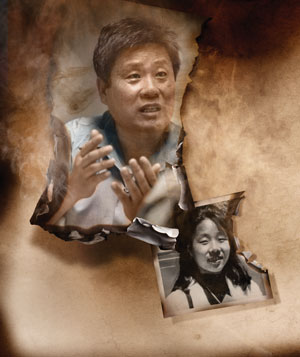
Illustration by Stephen Webster
So began the report and recommendation of a federal magistrate judge last year in the case of Han Tak Lee, a New York man then serving a life sentence in a Pennsylvania prison for the 1989 arson murder of his 20-year-old mentally ill daughter, Ji Yun Lee.
That proverb, inscribed at the University of Pennsylvania Law School on a bronze statue of Hsieh-chai, a mythological Chinese beast with the power to discern guilt, serves as a “fitting metaphor for both the progress of the law and the history of this case,” wrote Chief U.S. Magistrate Judge Martin C. Carlson of Harrisburg.
Carlson describes Lee’s long legal odyssey and the revolution in arson science that has taken place between the time of his 1990 trial and today.
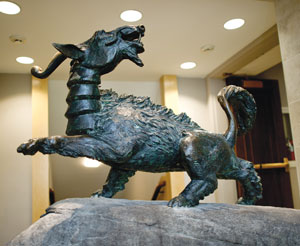
A plaque on this sculpture at the University of Pennsylvania Law School was quoted by the federal magistrate judge who freed Han Tak Lee. Photograph courtesy of Pennsylvania law school blog.
“Sometimes we find that truth eludes us,” he continued. “Sometimes, with the benefit of insight gained over time, we learn that what was once regarded as truth is myth, and what was once accepted as science is superstition. … So it is in this case.”
Carlson found that the fire science evidence at the heart of the prosecution’s case, undisputed at the time, has been debunked by more than two decades of research into the cause and origin of fires. He recommended that Lee’s conviction and sentence be vacated, and that prosecutors either retry or release him within 120 days.
Lee was freed on an unsecured bond in August 2014 after a federal judge adopted Carlson’s report and recommendation and conditionally granted Lee’s petition for habeas corpus relief. Prosecutors appealed to the Philadelphia-based 3rd U.S. Circuit Court of Appeals, which affirmed the lower court’s decision in mid-August.
Lee’s case is by no means unique, says renowned fire scientist John Lentini, who has seen a lot of bad science applied to arson investigations in his 40-plus years studying fires. But Lentini, who testified as an expert on Lee’s behalf on appeal, says Lee’s case is one of the worst he’s seen.
Lentini got involved in the early 1990s after a colleague sent him a transcript of the trial. He was so incensed by what he read that he called Lee’s lawyer and offered to work on the case for free. But the lawyer said that wouldn’t be necessary because Lee’s supporters in the Korean-American community raised enough money to cover his legal fees.
Lentini says prosecutors employed nearly every fire science myth in the book. “It’s the ultimate triumph of junk science,” he says.
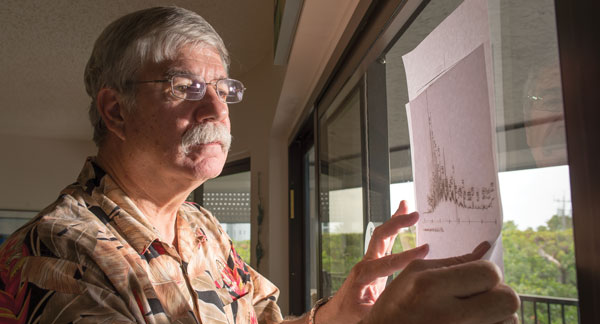
Veteran fire scientist John Lentini was appalled in the early 1990s after reading a transcript of Han Tak Lee’s arson murder trial. He says prosecutors used many fire science myths to convict Lee, and that the conviction was “the ultimate triumph of junk science.” Photo by Tom Salyer.
OLD SCIENCE, NEW SCRUTINY
Lee’s is just one of dozens of arson convictions around the country that have come under renewed scrutiny because of outmoded beliefs about how fires start and behave. Since 1989, 31 people have officially been exonerated—at least in part on the basis of new evidence that they did not commit arson, according to the National Registry of Exonerations.
But the registry is not all-inclusive. It doesn’t list the names of people like Louis Taylor, freed in 2013 after serving 42 years of a life sentence for a 1970 fire at a Tucson, Arizona, hotel that killed 29 people. Or James Hugney, set free earlier this year after serving nearly 36 years of a life sentence for a 1978 house fire that killed his 16-year-old son.
Nor does it include the name of Cameron Todd Willingham, a Texas man executed in 2004 for the 1991 arson murder of his three young daughters in a house fire that at least eight experts have since concluded was probably an accident.
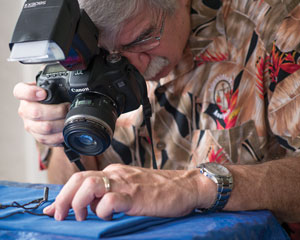
John Lentini. Photo by Tom Salyer.
And the actual number of people in prison for arson crimes they didn’t commit may be much higher because nobody knows how many individuals have been wrongfully convicted of arson-related offenses based on faulty fire science evidence. Most are indigent and have nobody to take up their cause. And arson convictions, as a rule, are particularly difficult to undo.
Arson cases are not like typical murder or rape cases, where DNA evidence may still exist that not only can establish one’s innocence but also implicate another. In arson cases, evidence is usually consumed in the fire. And a fire investigator can rarely rule out arson as the cause of a blaze, which is often a requirement for overturning a conviction.
Lentini, who has compiled a list of 55 cases in which he has been able to help people who have been falsely accused or wrongfully convicted of arson, estimates that there may still be as many as a “few hundred” innocent people in prison for arson-related offenses.
“What we see in terms of exonerations,” he says, “is just the tip of the iceberg.”
THE LIFE AND DEATH OF JI YUN LEE
In the summer of 1989, Han Tak Lee, a native of South Korea, was living in a Korean-American neighborhood in Queens, where he owned a clothing store, with his wife and two daughters. Ji Yun, the older of the two girls, had suffered from severe mental illness all her life. During her teenage years she experienced suicidal and homicidal thoughts. She had also undergone electroshock therapy. Shortly before her death, she had been prescribed lithium, which was intended to help control her violent mood swings.
In the early morning of July 28, 1989, police came upon Lee in the street outside his home, retrieving belongings his daughter had thrown out a window. Inside the house, police found Ji Yun in a “hyper” manic state, screaming at her parents, who were trying to get her to take her medication. They saw no evidence that anyone had tried to hurt her.
Later that day, at the suggestion of his pastor, Lee took his daughter to Camp Hebron, a religious camp run by the Korean Assembly of God church in the Pocono Mountains in Monroe County, Pennsylvania. At the camp, Ji Yun continued to behave erratically. She was overheard saying something to the effect that the camp would be her tomb. Later, when two pastors stopped by her cabin to pray, she became agitated and had to be physically restrained.
Early the next morning, Lee later told police, he awoke to find the cabin on fire. He said he fled and re-entered the cabin several times, trying to rescue his daughter, but couldn’t find her. He also said he managed to retrieve some personal belongings and had at one point slipped and fallen in a puddle of some unidentified liquid. He escaped, but Ji Yun died inside.
Police and firefighters arrived to find the cabin engulfed in flames. Told by bystanders that somebody might still be inside, they tried to enter the cabin but were repelled by the intense heat and flames. They found Lee sitting calmly on a bench across from the cabin, barefoot, with two packed bags at his side.
Once the fire had been put out, Ji Yun’s body was recovered from a hallway near the bathroom, curled in a fetal position. The cause of death was recorded as “conflagration,” which meant, essentially, that she had been incinerated. The carbon monoxide level in her bloodstream was later determined to be very low, suggesting that she stopped breathing almost immediately after encountering the fire.
Less than five hours after the fire was reported, Ji Yun’s death was declared a homicide. Five days later, Lee was charged with first-degree murder and arson.
THE PROSECUTION OF HAN TAK LEE
At Lee’s trial, fire marshal Thomas Jones of the state police (now retired), testified that he found patterns of deep charring, alligator charring (marks shaped like alligator skin) and crazed glass (finely fractured glass) in the remains of the cabin, all of which he said were consistent with a deliberately set fire using liquid accelerants. He also said he had identified at least eight separate points of origin, though no evidence of chemical accelerants had been found at any of those locations.
A second prosecution expert, certified fire protection specialist Daniel Aston (now deceased), testified that he could determine not only the order in which the fires were set but also the amount and type of accelerants that were used: 62 gallons of home heating fuel mixed with 12.2 pounds of gasoline or Coleman fuel. He also said the last of the fires had been set at the front door, effectively trapping Ji Yun inside.
Prosecutors bolstered their case with the testimony of state police chemist Thomas Pacewicz, who conducted a chemical analysis of the shirt and pants Lee was wearing on the night of the fire, as well as the remains of a plastic jug and rubber glove found inside the cabin. Pacewicz, also deceased, testified that his analysis of the evidence revealed chemical hydrocarbon profiles that were consistent with same mixture of home heating fuel and gasoline or Coleman fuel that Aston said had been used to set the fire.
In his closing argument to the jury, Monroe County District Attorney E. David Christine Jr. pointed to the test results as compelling proof of the defendant’s guilt, suggesting that a “crazy, suicidal girl” like Ji Yun wouldn’t have had the mental capacity to set the fire on her own. He also cited Ji Yun’s disruptive behavior the day before her death as a possible motive for her murder. “The person who set this fire knew what he was doing,” Christine said.
Lee’s trial lawyer, who later died, didn’t challenge the prosecution’s contention that the fire was deliberately set because he believed that the general acceptance of the fire science evidence at the time precluded him from making that claim. He argued instead that Ji Yun set the fire.
Faced with such seemingly immutable and damning evidence, Lee was convicted of arson and murder and given a mandatory life sentence without the possibility of parole. His post-conviction appeals have been wending their way through state and federal courts ever since.
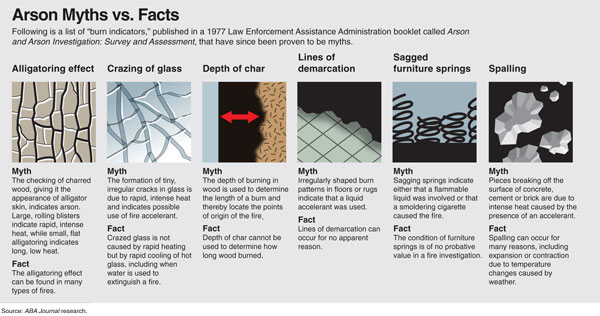
Chart by Sam Ward
MYTHS AND MISCONCEPTIONS
For decades, fire investigators relied on a set of erroneous beliefs and assumptions, akin to folklore, about what were thought to be the telltale signs of arson that were passed down from one generation to the next and accepted at face value.
Most investigators, whose jobs were to “catch arsonists,” were former police officers or firefighters with little or no scientific background or training. They learned on the job by watching experienced investigators who learned the trade from their superiors, perpetuating a belief structure that still influences some practitioners today.
At the time, the investigation of fires was viewed more as an art than a science, a mix born of experience and intuition. Fire debris was read like tea leaves. And investigators routinely interpreted the artifacts of a fire—burn patterns, charred wood, melted metal, collapsed furniture springs, spalled (chipped or scaled) concrete and crazed glass—as surefire indicators of arson.
Some of those myths were based on what seemed like intuitively “obvious” deductions, such as the notion that gas burns hotter than wood. Others were the result of unwarranted generalizations, like observing a pattern of spalling around the remains of a gasoline container and making an erroneous association between spalling and gasoline. But none of those so-called arson indicators was grounded in science.
In 1977, the now-defunct Law Enforcement Assistance Administration sought to collect arson expertise through a survey of fire investigators, but the effort may have done more harm than good. The results were published in a booklet that presented many of the myths of that era as fact.
Three years later, the National Bureau of Standards (now known as the National Institute of Standards and Technology) published the Fire Investigators Handbook, which repeated the myths published by the LEAA. Those myths in turn were cited and repeated in many other textbooks, further entrenching the errant mythology in the fire investigation community.
That began to change in the mid-1980s, when some members of the fire investigation community began to question the scientific basis for many prevailing myths. And in 1985, in an effort to address those concerns, the National Fire Protection Association—a group dedicated to fire safety and prevention—gathered a committee of experts from the scientific and fire investigation communities to develop guidelines for conducting fire and explosion investigations.
The result was a document called NFPA 921: Guide for Fire and Explosion Investigations, first published in 1992 and periodically updated since. It is now considered the fire investigator’s bible. NFPA 921 not only dispelled many of the myths fire investigators had long relied upon but marked the beginning of a movement within the profession to apply scientific principles to fire investigations.
The initial response to NFPA 921 in the fire investigation community was overwhelmingly negative. If what it said was true, Lentini says, it meant that hundreds—if not thousands—of accidental fires had been wrongly determined to have been intentionally set.
“No investigator wanted to admit to the unspeakable possibility that he had caused an innocent person to be wrongly convicted,” he says, “or a family denied their life savings.”
In 1998, a federal appeals court held for the first time that arson testimony is subject to the Daubert standard of reliability that applies to other forms of scientific expertise. Eventually, there were enough court rulings, including the U.S. Supreme Court’s 1999 holding in Kumho Tire Co. v. Carmichael, to persuade the majority of fire investigators to accept the scientific method in fire investigations.
One might think the debate over arson science would have ended once nationally recognized standards were promulgated and courts began demanding reliable evidence, says Case Western Reserve University law professor Paul Giannelli, the co-author of an academic treatise on scientific evidence. But such is not the case.
“Although the science exists to debunk these lingering fire investigation myths,” Giannelli asserts, “this kind of junk science continues to enter courtrooms through the testimony of some fire investigators who continue to ignore the science behind fire and rely on the ‘art’ of arson investigation.”
PUTTING SCIENCE IN ARSON SCIENCE
Early in his career, Lentini—then a private fire investigator with Applied Technical Services of Marietta, Georgia—had no reason to question the prevailing wisdom about fires. Then he was asked to look into the case of Gerald Wayne Lewis, a Jacksonville, Florida, man accused of setting a house fire in 1990 that killed his pregnant wife, her sister and her sister’s four children.
The fire bore many of the hallmarks of what was thought to be arson, including burn patterns and what appeared to be pour patterns on the floor that were believed to indicate the fire had been set using a liquid accelerant. Lewis said his son accidentally set fire to a sofa while playing with a lighter.
It happened that there was a nearly identical vacant house next door to the Lewis home that was to be demolished. Lentini and investigator John DeHaan got permission to outfit the vacant house with the same kind of furnishings as Lewis’ home and set fire to the couch without using an accelerant.
The house reached a point known as flashover—when the buildup of smoke and gas in an enclosed space causes the entire space to burst into flames—in less than five minutes, much faster than anyone thought possible. Afterward, Lentini and DeHaan found the same burn and pour patterns on the floor that they and everyone else once thought to be indicative of arson.
As a result of that experiment, which became known as “the Lime Street Fire,” the charges against Lewis were dropped. And the field of fire investigations was forever changed. “That case really opened my eyes,” Lentini says. “It made me see that what I and a lot of people thought we knew about arson was wrong.”
Lentini had another eye-opening experience in 1991 when he and three other investigators got a rare opportunity to study the after-effects of a fire they knew was not arson, visiting the scene of a fast-moving brush fire near Oakland, California, that destroyed 3,000 houses and killed more than two dozen people.
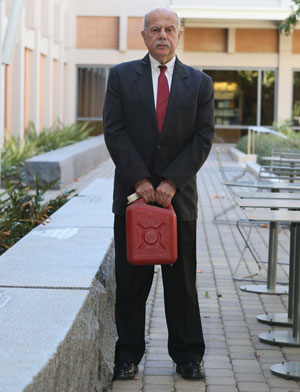
Law professor Edward Imwinkelried says a 1991 brush fire in Oakland, California, provided a watershed moment in fire science, showing that natural causes can produce signs once attributed to arson. Photo by Jonah Light.
The investigators, who examined 50 homes, found several indicators traditionally attributed to arson, including melted bedsprings, melted copper and crazed glass, which at the time was commonly thought to be caused by rapid heating through the use of an accelerant.
Back at the lab, Lentini conducted a simple experiment, which nobody apparently had thought to do, by heating up five types of glass in various ways at various speeds. It never crazed. But they all crazed when he sprayed them with water.
“The only thing crazed glass tells you is that the glass got hot and the fire department came and put out the fire,” he says.
Edward J. Imwinkelried, professor emeritus at the law school of the University of California at Davis and co-author (with Giannelli) of a book on scientific evidence, says the Oakland brush fire marked a turning point in the evolution of fire science.
“It’s as if God constructed an experiment to see if some of these old bromides people had been relying on for so long were actually grounded in science,” he says. “And it turned out they weren’t.”
Imwinkelried says the findings dramatized the need for a science-based approach to fire investigations.
EMBRACING SCIENCE
In the years since, research has rendered many of those old saws about arson obsolete and raised questions about the validity of the many convictions to which they contributed.
Around the year 2000, NFPA 921 became “generally accepted” by the fire investigation community, Lentini says, based on the court rulings that followed its publication.
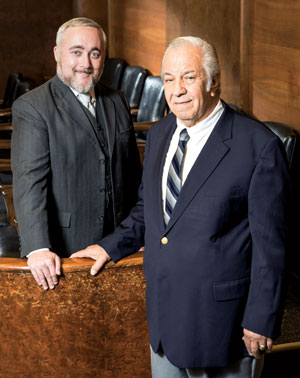
Justin McShane (left) got James Hugney released from prison after serving 36 years for an arson murder conviction based on faulty science. Photo by David Fonda.
In recent years, the percentage of structural fires determined to be arson has declined from about 15 percent in the late 1990s to about 6 percent today. That is probably due in part to the National Fire Protection Association changing its reporting standards in 2005 so that suspicious but undetermined fires are no longer included in the category of arson fires. But some of the downward trend is probably also due to fire investigators being more cautious about what they classify as arson, Lentini says.
Another development is the evolution of NFPA 1033: Standard for Professional Qualifications for Fire Investigator, Lentini says. The first edition was adopted in 1987. But the 2009 edition included significant changes, the most important of which listed subjects that fire investigators should have mastered beyond a high school level—including fire chemistry, thermodynamics, hazardous materials and failure analysis.
Those changes allow lawyers to challenge the qualifications of fire investigators who hold themselves as experts by asking some hard questions regarding their training and knowledge in those areas.
“If a fire investigator can’t answer these questions off the top of his head, it can be argued that he does not meet the minimum qualifications set forth in NFPA 1033,” Lentini says.
While he and most other experts believe the profession has improved markedly, they say there remains great variance in the field, with some practitioners still relying on the now-discredited techniques used for generations.
Most states have no legal requirements for a person to become a fire investigator. Private fire investigators in most states must be licensed. But they’re licensed as private investigators, not fire investigators, and no state requires a licensed private investigator to know anything about investigating fires.
To this day, most fire investigators are not scientists. A recent survey of 217 fire investigators by a student from National University in San Diego found that only 14 percent had an advanced degree of any kind. Thirty-four percent had a college degree. But 13 percent had only a high school education. One percent had only a GED. A 2013 survey of 586 public sector fire investigators by two Eastern Kentucky University professors found that some myths are still commonly believed to be indicators of arson. Nearly 40 percent did not know that crazed glass is caused by rapid cooling, not rapid heating. Twenty-three percent think puddle-shaped burns indicate the use of an accelerant. Eight percent still believe that alligator blistering implies that a fire burned fast and hot.
On the other hand, only 4 percent of respondents believed that intense heat caused by an accelerant causes concrete to spall. And almost nobody believed that sagged or collapsed furniture springs say anything definitive about the cause or origin of a fire.
Justin McShane, a Harrisburg, Pennsylvania, lawyer who has handled several arson cases, including the one that resulted in Hugney’s release, says the system needs better ways to address wrongful convictions based on discredited forensic techniques.
“Forensic science changes all the time,” he says, “and if we find out the science was wrong, we ought to admit it and rectify it—not fight it just to preserve a conviction.”
McShane hails the passage of a 2013 law, said to be the first of its kind in the country, that expressly allows the Texas Court of Criminal Appeals to grant a defendant a new trial in cases where the underlying forensic science is shown to be flawed. A similar law, known as a junk science writ, took effect earlier this year in California.
In most states, including Pennsylvania, McShane says, it’s virtually impossible to win a new trial based on faulty forensic science more than a year after a conviction becomes final without the cooperation of the prosecutor.
Phoenix lawyer Larry Hammond, who has helped free three men wrongfully convicted of arson, including Taylor, says it’s fair to say that a lot of progress has been made in fire investigations in the 35 years since he took on his first arson case. But there’s still no assurance that junk science won’t be used in court to convict an innocent person of an arson-related offense.
“There is still no nationwide set of rules governing who can testify as a fire expert,” Hammond says. “And there are still a lot of people out there who consider themselves experts who pay no attention to [prevailing] fire science standards.”
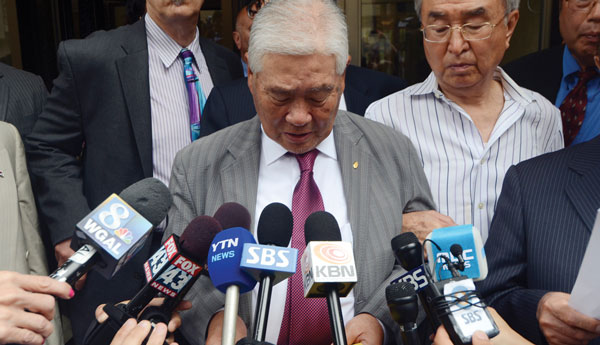
Han Tak Lee faces reporters on Aug. 22, 2014, after 25 years in prison for the arson murder of his daughter. Fire science evidence that helped convict him has been debunked. AP Photo/Marc Levy.
LEE’S LONG ROAD TO EXONERATION
For more than two decades, Lee couldn’t find a court willing to consider his claim of innocence. But in 2012, the 3rd Circuit held that he was entitled to a hearing on his contention that advances in the field of arson had eroded the scientific foundation on which his conviction rested.
Prosecutors conceded that the fire science evidence presented at Lee’s trial was no longer valid. But they insisted there was ample other evidence pointing to his guilt. They also acknowledged that results from tests Pacewicz conducted had gone missing.
Yet the evidence survived, and a new analysis by Lentini, the defense’s expert, dealt another blow to the state’s case. Contrary to Pacewicz’s testimony, Lentini said that the chemical composition of substances found on three items of evidence used at trial were nothing alike.
It is now clear, Judge Carlson said in his 45-page report and recommendation, that the state’s fire science evidence—which was a critical component in the quantum of proof that led to Lee’s conviction—is invalid, and that much of what was presented to Lee’s jury as science is little more than superstition.
And, with the collapse of the now-discredited fire science evidence, he added, the state’s case against Lee rested on “thin reeds”: minor discrepancies in his accounts of the fire; his daughter’s disruptive behavior the day before the fire; his stoic nature after the fire; and the autopsy findings for Ji Yun, which suggested she could have been incapacitated prior to her death.
“Individually, these shards of evidence are equivocal; and collectively, they simply do not reach the quantum of proof, ‘ample evidence’ of guilt upon which the jury could have relied,” he wrote.
U.S. District Judge William J. Nealon agreed, adopting what he said was Carlson’s “well-reasoned” report and recommendation. The 3rd Circuit affirmed, saying the state had failed to produce ample evidence sufficient to prove guilt beyond reasonable doubt.
Prosecutor Christine, who didn’t respond to several requests for comment, told the Associated Press he was considering an appeal to the U.S. Supreme Court, citing what he said was “relevant and admissible evidence” establishing Lee’s guilt.
But Peter Goldberger, Lee’s current lawyer, calls on Christine to acknowledge there is no basis for this conviction, admit the case is finally over and drop all charges.
“I don’t expect him to say he’s sorry, but that’s OK,” Goldberger says. “He doesn’t have to say he’s sorry as long as he does the right thing.”
This article originally appeared in the December 2015 issue of the ABA Journal with this headline: “Badly Burned: Long-held beliefs about arson science have been debunked after decades of misuse and scores of wrongful convictions.”



